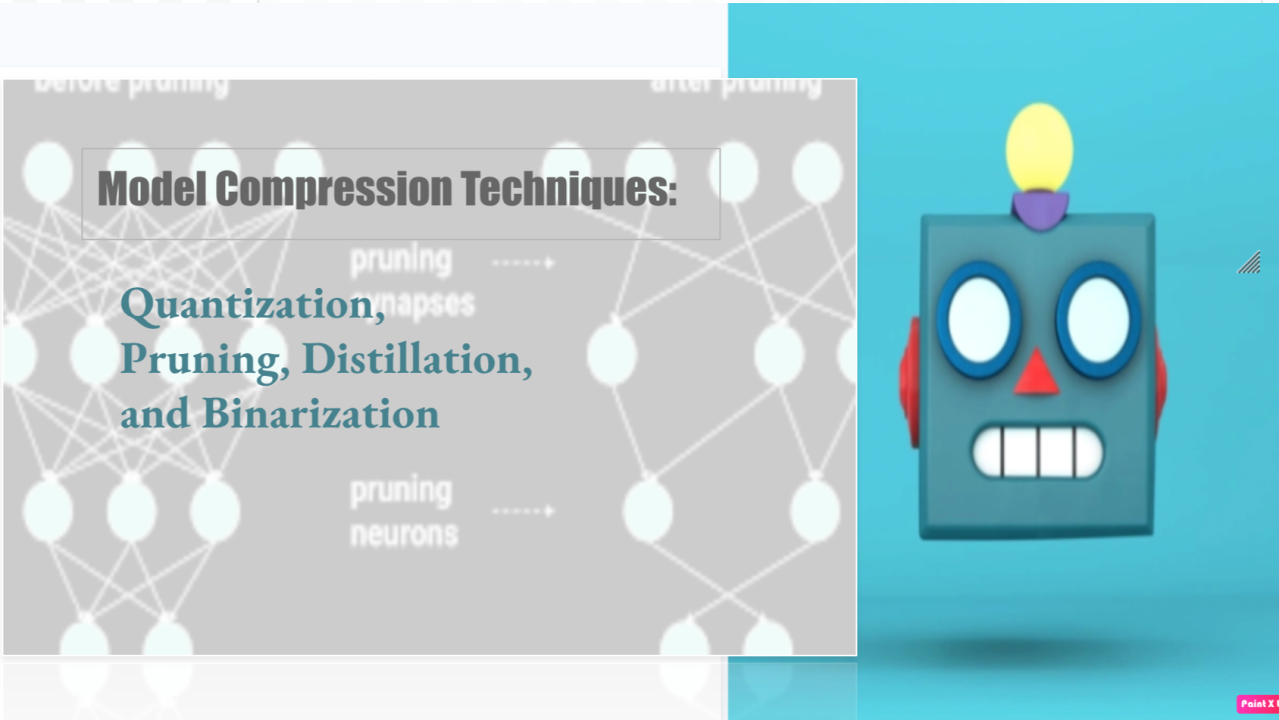
Model Compression Techniques: Quantization, Pruning, Distillation, and Binarization
Florent LIU
Data architect, Full Stack Data Engineer in BIG DATA, and Full Stack Developer AI.
1. Introduction to Model Compression
Model compression techniques aim to reduce the size and computational cost of large models while maintaining their predictive performance.
Large deep learning models are increasingly deployed in resource-constrained environments (e.g., mobile devices or edge computing).
However, their substantial memory and computation requirements hinder real-time inference and efficient deployment. Compression methods—by reducing model size and latency—facilitate broader adoption without sacrificing performance.
Below is a detailed introduction on model compression techniques, focusing on four core methods: quantization, pruning, distillation, and binarization.
2. Quantization
Quantization reduces the precision of model weights and activations from high-precision floating-point numbers (e.g., 32-bit) to lower-precision representations (e.g., 8-bit), thereby decreasing memory footprint and speeding up computations.
By lowering numerical precision, quantization minimizes both storage and computational overhead. Techniques such as post-training quantization and quantization-aware training help mitigate accuracy loss. Calibration is crucial to maintain the model's performance while taking advantage of hardware acceleration on low-precision arithmetic units.
REFERENCE: Recent implementations have shown that 8-bit quantization can reduce model size by up to 75% while retaining most of the original accuracy (Jacob et al., 2018). APA Citation: Jacob, B., Kligys, S., Chen, B., Zhu, M., Tang, M., Howard, A., ... & Kalenichenko, D. (2018). Quantization and training of neural networks for efficient integer-arithmetic-only inference. Proceedings of the IEEE Conference on Computer Vision and Pattern Recognition, 2704–2713. Retrieved from https://openaccess.thecvf.com/content_cvpr_2018/html/Jacob_Quantization_and_Training_CVPR_2018_paper.html
3. Pruning
Pruning involves eliminating weights or neurons that contribute little to model performance, creating sparse architectures that require fewer computations and less memory.
Pruning methods can be unstructured (removing individual weights) or structured (removing entire neurons or filters), with the latter often offering more practical speedups on hardware. The challenge is to identify and remove redundant parameters without significant degradation in accuracy.
The resulting sparse models can then be fine-tuned to recover any lost performance.
REFERENCE: Empirical studies demonstrate that aggressive pruning (removing 90% or more of parameters) can still maintain near-original performance levels in many models (Han et al., 2015). APA Citation: Han, S., Pool, J., Tran, J., & Dally, W. J. (2015). Learning both weights and connections for efficient neural network. Advances in Neural Information Processing Systems, 28, 1135–1143. Retrieved from https://papers.nips.cc/paper/2015/file/ae0e9a2aab3ac8c4f057f5b86c3b91d0-Paper.pdf
领英推荐
4. Distillation
Distillation transfers knowledge from a large “teacher” model to a smaller “student” model, enabling the student to approximate the teacher’s performance with far fewer parameters.
The process involves training the student model to mimic the soft output (probabilities) of the teacher model. This captures the teacher’s nuanced decision boundaries, enabling the smaller model to generalize well. Distillation is particularly valuable when deploying models in latency-sensitive environments, as it reduces both model size and inference time.
RERERENCE: Hinton et al. (2015) demonstrated that a distilled student model could achieve performance close to its teacher while being significantly smaller and faster. APA Citation: Hinton, G., Vinyals, O., & Dean, J. (2015). Distilling the knowledge in a neural network. arXiv preprint arXiv:1503.02531. Retrieved from https://arxiv.org/abs/1503.02531
5. Binarization
Binarization reduces weights and activations to binary values (typically +1 and –1), drastically minimizing memory and computational requirements.
While binarization offers the most extreme form of compression, it usually incurs a significant drop in model accuracy. Researchers are developing specialized training techniques (e.g., using real-valued gradients) to mitigate this loss. Binarized networks are attractive for hardware implementations due to their potential for near-constant time arithmetic and extreme power efficiency.
REFERENCE: Courbariaux et al. (2016) showed that binarized neural networks can perform competitively on standard benchmarks, albeit with a trade-off between compression ratio and accuracy. APA Citation: Courbariaux, M., Hubara, I., Soudry, D., El-Yaniv, R., & Bengio, Y. (2016). Binarized neural networks: Training deep neural networks with weights and activations constrained to +1 or -1. arXiv preprint arXiv:1602.02830. Retrieved from https://arxiv.org/abs/1602.02830
6. Conclusion and Trade-offs
Each model compression technique offers a unique balance between compression ratio and accuracy retention, and in practice, combinations of these methods are often employed to achieve optimal performance on resource-constrained devices.
Quantization is effective for reducing precision while maintaining most performance, pruning removes redundancy, distillation transfers knowledge effectively, and binarization provides extreme compression at the cost of accuracy. The choice of method depends on the deployment scenario and hardware constraints. Often, hybrid approaches that combine several techniques yield the best trade-off between efficiency and performance.
REFERENCE: Comprehensive benchmarks in the literature show that combining these methods can lead to significant improvements in speed and memory usage without compromising accuracy substantially (Han et al., 2016; Hinton et al., 2015; Courbariaux et al., 2016). APA Citation: See Han et al. (2016), Hinton et al. (2015), and Courbariaux et al. (2016) for detailed empirical results on compression trade-offs.
#AI #DataScience #data #generative ai #reinforcement learning optimization #model optimization techniques #fine tuning llms